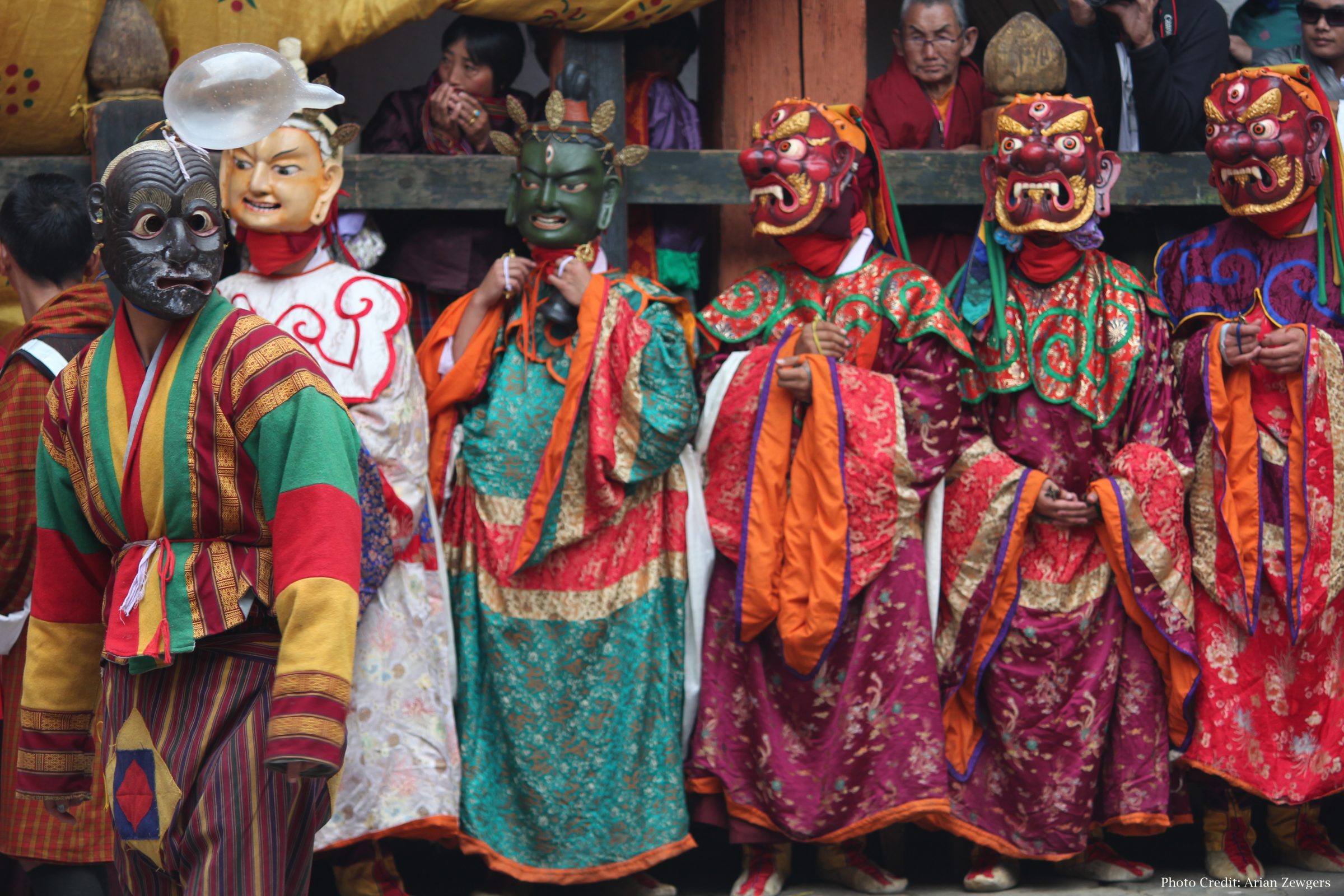
2020 Festival and events Calendar
Festivals, known as T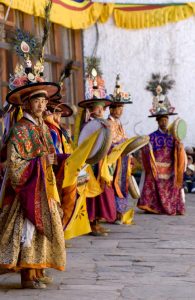 shechu, play an important role in the communal lives of the Bhutanese. The word ‘tshechu’ literally translates to the ‘tenth day’; and traditionally, a tshechu celebrates the life and deeds of Guru Rinpochhe – a Buddhist saint who is widely regarded as the patron saint of the Himalayan region. The core attraction of tshechus are the cham dances – operatic enactments of the Guru’s deed and other Buddhist fables by masked dancers.
shechu, play an important role in the communal lives of the Bhutanese. The word ‘tshechu’ literally translates to the ‘tenth day’; and traditionally, a tshechu celebrates the life and deeds of Guru Rinpochhe – a Buddhist saint who is widely regarded as the patron saint of the Himalayan region. The core attraction of tshechus are the cham dances – operatic enactments of the Guru’s deed and other Buddhist fables by masked dancers.
However, in this day and age, tshechus have evolved from just being religious spectacles to a celebration of local cultures and lifestyle; and quite a few new tshechus and events have been developed and added to the festival calendar over the years. The following is a list of festivals along with a short description and the dates for the 2020 calendar year.
Punakha Drubchen (at Punakha Dzong, Punakha): One of the oldest festivals in the country, the Punakha Drubchen was first started in the 17th century. The Drubchen was initiated by Zhabdrung Ngawang Namgyal to celebrate the victory over invading Tibetan forces. A brief history on the construction of the Dzong is showcased to the general public. This is followed by masked and folk dances. (2nd to 4th March)
Punakha Tshechu (at Punakha Dzong, Punakha): Held right after the Punakha Drubchen, the Punakha Tshechu is attended by thousands of people from across the country and abroad. The unfurling of the Guru Thongdrel (a gigantic silk tapestry with the image of Guru Rinpoche on it) is the main attraction of the festival. (5th to 7th March)
Bhutan International Marathon (at Punakha): The Bhutan International Marathon is an annual event held in Punakha. You can either run the full marathon (42 kilometers/26.2 miles) or the half marathon (21 kilometers/13.1 miles). The marathon is run on a mix of hard-packed dirt and pavement in a mostly rural setting. All profits from the marathon will go towards supporting Bhutan’s Youth and Olympic sports programs. (7th March)
Tharpaling Thongdrel (at Tharpaling Lhakhang, Bumthang): The Tharpaling Thongdrel is a one day festival held on the grounds of Tharpaling Lhakhang. Unlike other religious festivals, no masked dances are performed during the festival. The main attraction of the festival is the unfurling of a thongdrel of Jowo Jampa (Maitreya Buddha/future Buddha). This is preceded by the offering of prayers. (9th March)
Talo Tshechu (at Talo Goenpa, Punakha): A three day festival held in Talo village, the festival is particularly popular for its masked dances. A zhungdra (a form of traditional folk music and dance) performance by the Talo dance troupe is one of the main attractions of this festival. (1st to 3rd April)
Gasa Tshechu (at Gasa Dzong, Gasa): It is held in the courtyard of the Gasa Dzong. Until 2010, the festival featured only one performance – a three hundred year old goenzhey (traditional song) believed to have been written by the Zhabdrung during his arrival in Bhutan from Tibet. Since then, the festival has also included masked dances and folk songs in its list of performances. (1st to 3rd April)
Gomphu Kora Tshechu (at Gomphu Kora, Trashigang): ‘Gomphu’ means ‘meditation cave’ and ‘kora’ means ‘circumambulation’. According to legend, an evil spirit had fled from Tibet to Bhutan, and the great Indian saint – Guru Padmasambhava – followed the spirit. The malevolent being hid itself in a cave, and the Guru followed the spirit into the cave. The Guru meditated for three days inside the cave and managed to subdue the spirit. The cave the Guru meditated in came to be known as Gomphu Kora; and since then, the cave has become one of the most famous meditation spots in the Himalayan Buddhist world. A three day festival is held in honour of Guru Padmasambhava and to celebrate the triumph of good over evil. (1st to 3rd April)
Zhemgang Tshechu (at Zhemgang Dzong, Zhemgang): The Zhemgang Tshechu is a three day festival held in the most remote district of Bhutan. The three day festival culminates with the unfurling of a Guru Thongdrel on the last day. (1st to 3rd April)
Paro Tshechu (at Rinpung Dzong, Paro): Along with the Thimphu Tshechu, the Paro Tshechu is possibly the most popular festival in Bhutan in terms of attendance and participation. The masked dances, the intricate textiles worn by attendees, and the swirl of colours makes the Paro Tshechu a marvelous spectacle to witness. (4th to 8th April)
Chhorten Kora at Chhorten Kora, Trashiyangtse: This festival is held on the grounds of the famous Chhorten Kora in Bhutan’s easternmost district – Trashiyangtse. The festival is split up into two parts – the Dakpa Kora and the Drukpa Kora. The Dakpa Kora is held on the 15th day of the 3rd month in the Bhutanese lunar calendar, and the Drukpa Kora is held on the 30th day of the 3rd month in the Bhutanese lunar calendar. According to legend, a demon lived upon the spot that the Chhorten currently stands and terrorized the locals of the place. To subdue the demon, a Bhutanese monk decided to build a Chhorten in that place, and a young girl from Tawang (in the neighbouring Indian state of Arunachal Pradesh) volunteered to be interred alive inside the Chhorten. The Dakpa and Drukpa Koras are organized every year in remembrance of this selfless deed by the Arunachali girl. Thousands of people from Arunachal make their way across the border in order to attend the festival. (8th & 22nd April)
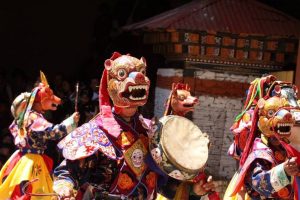
Rhododendron Festival at Lamperi Botanical Garden, Dochula, Thimphu: The Rhododendron Festival is a small community-based festival. The local communities of the region surrounding Lamperi participate in it and it is an opportunity for them to display their local traditions and customs through dances and songs, arts and crafts, and local cuisine. The festivals objective is to create opportunities for local communities and to promote ecotourism. (19th to 21st April)
Domkhar Tshechu (at Domkhar, Bumthang): The masked dances at the festival were mostly composed by one of Bhutan’s most well-known saints – Terton Pema Lingpa. The performers are locals from Domkhar Village, and many believe that the festival dates back to the 18th century. (3rd to 5th May)
Ura Yakchoe (at Ura Lhakhang, Bumthang): Famous for its Ura Yakchoe dance. According to legend, an old woman was sitting outside her house when a monk who was passing by asked for a drink of water. When she came out to give the monk water, he had mysteriously vanished only leaving a bag behind. Out of curiosity, the woman opened the bag and came across a statue. This statue is the centerpiece of the Ura Yakchoe festival. Scores of people from the Ura Valley and the district of Bumthang attend the festival to get blessings from the statue. (4th to 8th May)
Nimalung Tshechu (at Nimalung Dratshang, Bumthang): The Nimalung Tshechu is an annual festival that is usually held in the 5th month of the Bhutanese Lunar Calendar. A relatively small festival in comparison to some of the other tshechus, the Nimalung Tshechu is an intimate affair attended by locals from Nimalung and the neighbouring villages. (30th June and 1st July)
Kurjey Tshechu (at Kurjey Lhakhang, Bumthang): The Kurjey Tshechu is an annual festival held on the grounds of Kurjey Lhakhang. The Monastery was built in the 17th century by Chogyal Minjur Tempa, the first Poenlop (governor) of Trongsa. It is believed that the Indian Saint Guru Padmasbhava subdued Shelging Karpo (a Bon deity) and converted him into a protector of the Buddha’s Dharma on the spot where the Monastery is built. The Kurjey Tshechu is one of the bigger festivals held in Bumthang, and scores of people from the four valleys of Bumthang and the neighbouring districts make it a point to attend the festival. (30th June)
Haa Summer Festival (at Haa): The Haa Summer festival celebrates and pays homage to the traditions and lifestyles of Bhutan’s nomadic community.There will be opportunities to participate in local games, sample delicious homemade cuisine, and enjoy traditional folk songs and dance. (13th and 14th July)
Matsutake Festival (at Genekha, Thimphu): The Matsutake mushroom is a prized fungi, known to fetch very high prices in the Japanese and east Asian market. For many people in rural Bhutan, the Matsutake mushroom is a major source of income. The festival celebrates the start of the matsutake mushroom season. At the festival, visitors will be learn to identify these fabled mushrooms as they embark on mushroom picking excursions around the pristine forests and hills. They’ll be able to sample delicious Matsutake recipes, engage in songs and dances together with the locals, and hike through the stunning Himalayan landscape. (15th and 16th July)
Tour of the Dragon (starts at Chamkhar, Bumthang and ends at Thimphu): Although not a festival in the traditional sense, the Tour of the Dragon is an exciting event that many people have marked on their calendars. The Tour of the Dragon is a bicycle race that starts at Chamkhar, Bumthang and ends at Thimphu. The 268 kilometer race has been billed as the “World’s toughest one day bicycle race”, and it will take you over four mountain passes and several different climes from the sub-alpine mountain passes of Bumthang to the subtropical valley of Punakha to the moderate and temperate climate of Thimphu. (6th September)
Thimphu Drubchhen (at Tashichho Dzong, Thimphu) : This festival was started in 1701 by Kuenga Gyeltshen, the reincarnation of Jambay Dorji – the Zhabdrung’s first son. The Dromchoe showcases the sacred dances dedicated to the protecting deity of Bhutan, Palden Lhamo. Legend has it, that the deity Pelden Lhamo appeared before Kue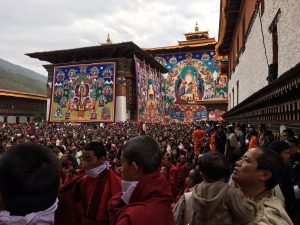 nga Gyeltshen and performed the dances while he was in meditation. Based on these dances, Kuenga Gyaltshen initiated the dance ceremony. (22nd September)
nga Gyeltshen and performed the dances while he was in meditation. Based on these dances, Kuenga Gyaltshen initiated the dance ceremony. (22nd September)
Wangdue Tshechu (at Tencholing Army Ground, Wangduephodrang): The Wangdue Tshechu was started in 1639 by Zhabdrung Ngawang Namgyal – the founder of Bhutan as a nation state. The tshechu used to be held in the courtyards of the Wangduephodrang Dzong. However, the Dzong was sadly lost to a fire in 2012. Since then the festival has been relocated to the Tencholing Army Ground. The three-day annual festival is attended by people from all parts of Bhutan and provides them with an occasion for merrymaking and revelry. (24th to 26th September)
Tamshing Phala Chhoepa (at Tamshing Lhakhang, Bumthang): The festival is held at Tamshing Lhakhang, built in 1501 by Terton Pema Lingpa – one of the five terton kings and perhaps Bhutan’s most famous historical figure. (26th to 28th September)
Thimphu Tshechu (at Tashichho Dzong, Thimphu): Possibly the most popular festival in the country in terms of attendance and participation, the Thimphu Tshechu is a three day festival and it is a wonderful event to take part in. It was started in 1867, and it has been a mainstay in the Bhutanese festival calendar since then. (26th to 28th September)
Gangtey Tshechu (at Gangtey Goenpa, Phobjikha, Wangduephodrang): The three day festival is held in the courtyard of Gangtey Goenpa – a spectacular monastery situated on a hill that overlooks the glacial valley of Phobjikha. Until recently, the festival was an intimate affair that was mostly attended by locals. (28th September to 1st October)
Thangbi Mani (at Tangbi Lhakhang, Bumthang): A festival held on the grounds of the Tangbi Monastery. It is a small and intimate community-based festival organized by the villages of Tangbi, Goling, and Kharsath. (29th September to 2nd October)
Jumolhari Mountain Festival (at Jangothang, Paro): The festival is a two-day event organized by the local communities of Jangothang, Soe Yaksa, Thangthanka, and Soe Yutey with assistance from the Department of Forest and Park Services and the Bhutan Foundation. The festival celebrates the lifestyle and cultures of the many communities that live around Mount Jumolhari. The festival also hopes to raise awareness on the Snow Leopard and conservation efforts to protect the magnificent creature. (14th and 15th October)
Royal Highlander Festival (at Laya, Gasa): A celebration of the nomads and their lifestyles. This two-day festival has been organized with the objective of revitalizing commerce and trade in the highlands and to promote and maintain a sustainable livelihood for the communities that dwell there. During the festival, nomadic highlanders from all corners of Bhutan get together for a two-day celebration of their rich cultures and traditions. (23rd and 24th October)
Jakar Tshechu (at Jakar Dzong, Bumthang): The Jakar Tshechu is one of the larger festivals in the spiritual heartland of Bhutan – Bumthang. Held in the courtyard of Jakar Dzong, the festival is attended by scores of people from not the four valleys of Bumthang but also by pilgrims and tourists from across the country and abroad. (23rd to 27th October)
Chhukha Tshechu (at Chhukha Dzong, Chhukha): The Chhukha Tshechu is a three day festival held at Chhukha Dzong. The three day festival is a celebration of the life of Guru Rinpochhe (Bhutan’s patron saint), and it culminates with the unfurling of a Guru Thongdrel on the last day. (24th to 26th October)
Jambay Lhakhang Drup (at Jambay Lhakhang, Bumthang): A spectacular five day festival held on the grounds of Jambay Lhakhang, one of the oldest monasteries in the country. The highlight of the festival is the fire ritual that is held in the evening. The ritual is performed by nude masked dancers, and huge crowds usually gather to watch the spectacle. (31st October to 3rd November)
Prakhar Duchhoed (at Prakhar Lhakhang, Bumthang) : A small community-based festival held in honour of Lama Thukse Dawa, the son of Bhutan’s most famous saint – Terton Pema Lingpa. The festival is held on the grounds of the the Prakhar Monastery. (1st to 3rd November)
Black Necked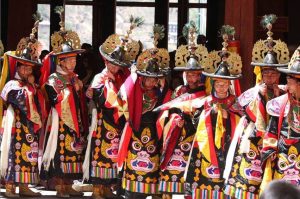 Crane Festival (at Gangtey, Wangduephodrang) : An annual festival that is held in the courtyard of Gangtey Goenpa, a monastery that was built in early 17th century. The festival is a time for locals to rejoice, make merry, and to celebrate the arrival of the majestic black-necked cranes from their winter homes in Tibet. (11th November)
Crane Festival (at Gangtey, Wangduephodrang) : An annual festival that is held in the courtyard of Gangtey Goenpa, a monastery that was built in early 17th century. The festival is a time for locals to rejoice, make merry, and to celebrate the arrival of the majestic black-necked cranes from their winter homes in Tibet. (11th November)
Pemagatshel Tshechu (at Pemagatshel Dzong, Pemagatshel): The festival was started in the 1980’s. It has become famous for its distinctive songs and dances, particularly a folk song know as ausa. Ausa is usually sung when one’s friends, family, or loved ones depart for another place. (21st to 24th November)
Nalakhar Tshechu (At Nalakhar, Bumthang): A small festival held by the community of Nalakhar. Nalakhar is a quaint and rural village in Bumthang district. The festival has been organized to propitiate the local deities, give thanks for a good harvest and to gain blessings for an even better harvest in the seasons to come. (30th November to 2nd December)
Druk Wangyel Tshechu (at Dochula, Thimphu): The Druk Wangyel Tshechu is unique in the sense that all the dances and performances are performed by members of the armed forces rather than monks or lay people. It is a tribute to the great Fourth King of Bhutan, and his role in protecting the sovereignty of the country and ensuring its stability. (13th December)
Trongsa Tshechu (at Trongsa Dzong, Trongsa): The Tshechu is held in the magnificent Trongsa Dzong – the largest Dzong in Bhutan. One of the oldest festivals, it is believed that the tradition of holding Tshechus started from Trongsa and spread to its neighbouring regions. (10th to 13th December)
Lhuentse Tshechu (at Lhuentse Dzong, Lhuentse): The Lhuentse Tshechu takes place in the district of Lhuentse – the ancestral birthplace of Bhutan’s Kings. The three day festival brings in scores of people from all. (21st to 24th December)
Nabji Lhakhang Drup (at Nabji Lhakhang, Trongsa): A small festival that takes place in the quaint village of Nabji in Trongsa, the Nabji Lhakhang Drup is an intimate and charming affair. Two of the key highlights of the festival are the Mewang (Fire dance/blessing) and the Tercham (dance of the treasure). It is believed that the Tercham can cure infertility in women. (29th to 31st December)